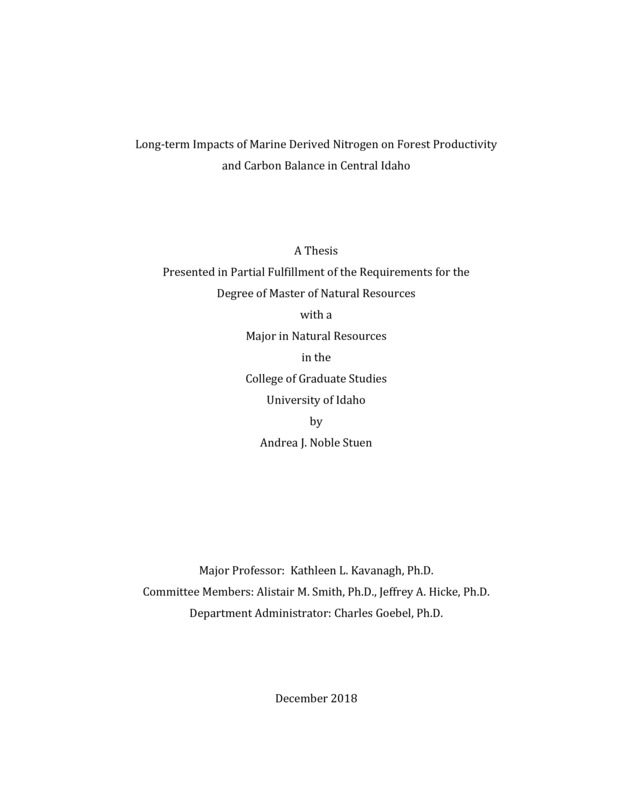Long-term Impacts of Marine Derived Nitrogen on Forest Productivity and Carbon Balance in Central Idaho
Noble Stuen, Andrea. (2018-12). Long-term Impacts of Marine Derived Nitrogen on Forest Productivity and Carbon Balance in Central Idaho. Theses and Dissertations Collection, University of Idaho Library Digital Collections. https://www.lib.uidaho.edu/digital/etd/items/noblestuen_idaho_0089n_11487.html
- Title:
- Long-term Impacts of Marine Derived Nitrogen on Forest Productivity and Carbon Balance in Central Idaho
- Author:
- Noble Stuen, Andrea
- ORCID:
- 0000-0002-4781-850X
- Date:
- 2018-12
- Program:
- Natural Resources
- Subject Category:
- Ecology; Biogeochemistry; Forestry
- Abstract:
-
Wild anadromous fish such as Pacific Chinook salmon (Oncorynchus tshawytscha) and steelhead (Oncorhyncus mykiss) were once abundant in Idaho, where their carcasses, rich in marine-derived nutrients (MDN) provided a nitrogen subsidy to otherwise nutrient-poor riparian soils. This nutrient subsidy ceased in the early 20th century due to dams that blocked fish passage. This study investigates the long-term cumulative effect of ongoing absence versus presence of MDN on the carbon balance of riparian forests along historically salmon-bearing streams in the North Fork Boise River watershed in Idaho.
The ecosystem process model BIOME-BGC is used to simulate a representative forest ecosystem and predict the impact of decades of addition compared to continuing absence of MDN on riparian forest net primary productivity (NPP) and net ecosystem production (NEP). The model is parameterized using local ecophysiology and site data and 23 years of site-adjusted local climate data. Simulations were run for control (no MDN since 1904), and low and high MDN scenarios (1.6 and 5.3 kg/ha/year based on historical estimates). The control simulation correctly predicted present-day forest measures of LAI (a proxy for NPP) and soil moisture across six study sites. Simulated experimental addition of marine-derived nitrogen led to increases in productivity (NPP) by 7-8% annually, C sequestration (NEP) by up to 48% annually, and to the standing site C pool by 3%, or 4.4 tons C per kilometer of stream that would be added to the present day landscape were anadromous fish still present at historical levels. The magnitude of these effects varied substantially with environmental conditions. When other limiting factors were least restricting, MDN had its greatest effects, most notably in the wet early growing season and at the cooler, wetter higher elevation sites, and in years with high precipitation during the growing season. With nearly 20,000 km of historic salmon bearing streams on varied terrain within the Columbia Basin, these results indicate that salmon had a large, but heterogeneous, impact on the regional vegetative carbon balance.
- Description:
- masters, M.S., Natural Resources -- University of Idaho - College of Graduate Studies, 2018-12
- Major Professor:
- Kavanagh, Kathleen
- Committee:
- Smith, Alistair; Hicke, Jeffrey
- Defense Date:
- 2018-12
- Identifier:
- NobleStuen_idaho_0089N_11487
- Type:
- Text
- Format Original:
- Format:
- application/pdf
- Rights:
- In Copyright - Educational Use Permitted. For more information, please contact University of Idaho Library Special Collections and Archives Department at libspec@uidaho.edu.
- Standardized Rights:
- http://rightsstatements.org/vocab/InC-EDU/1.0/

